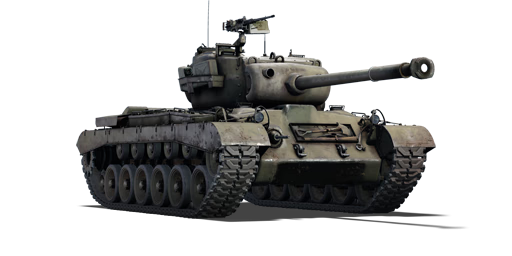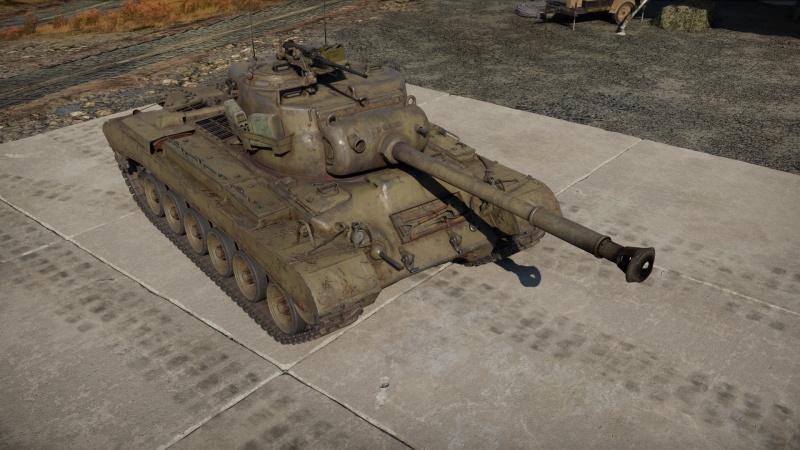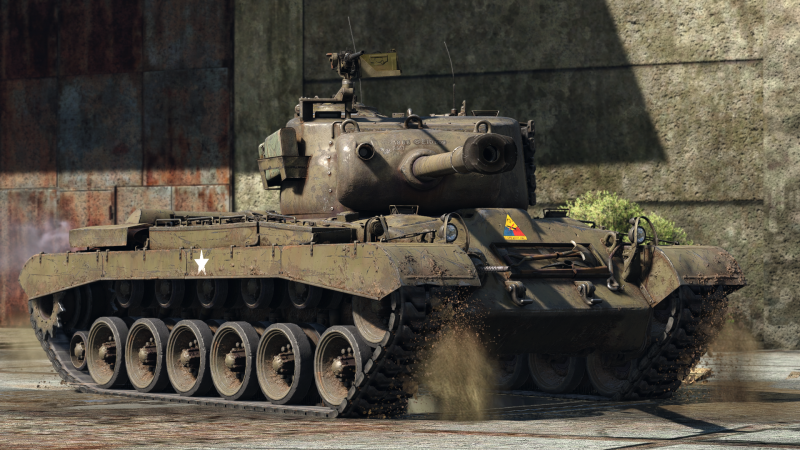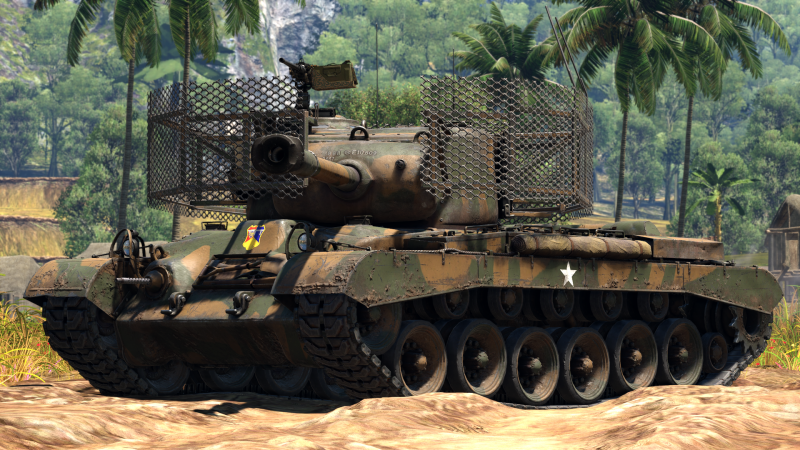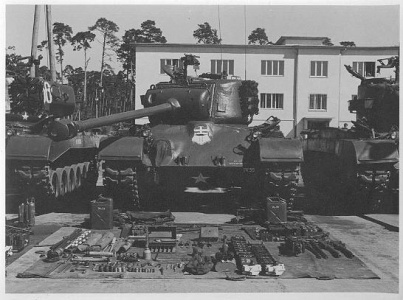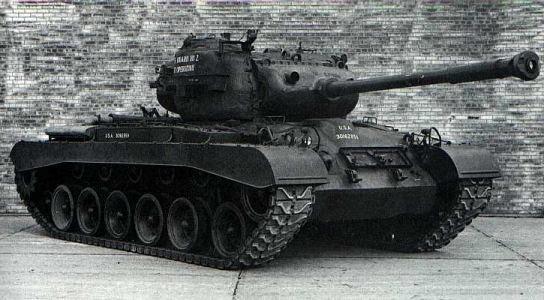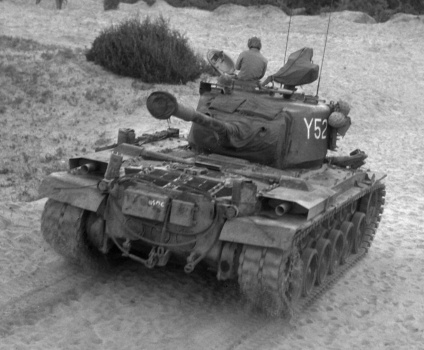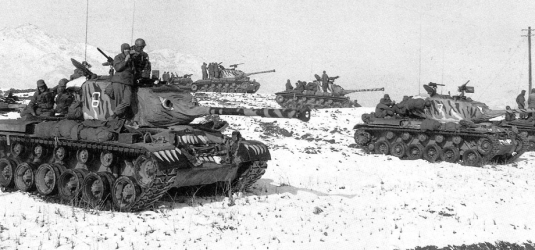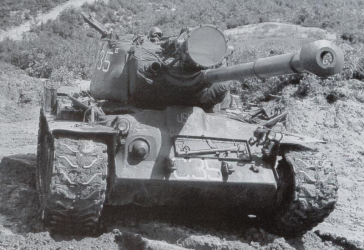Difference between revisions of "M46"
Colok76286 (talk | contribs) (→Ammo racks: Updated section) |
(→Description) |
||
| (23 intermediate revisions by 7 users not shown) | |||
| Line 1: | Line 1: | ||
| + | {{About | ||
| + | | about = American medium tank '''{{PAGENAME}}''' | ||
| + | | usage = the premium vehicle | ||
| + | | link = M46 "Tiger" | ||
| + | }} | ||
{{Specs-Card | {{Specs-Card | ||
|code=us_m46_patton | |code=us_m46_patton | ||
| − | |images={{Specs-Card-Image|GarageImage_{{PAGENAME}}.jpg}} | + | |images={{Specs-Card-Image|GarageImage_{{PAGENAME}}.jpg|ArtImage_{{PAGENAME}}.png|ArtImage2_{{PAGENAME}}.png}} |
}} | }} | ||
== Description == | == Description == | ||
<!-- ''In the description, the first part should be about the history of the creation and combat usage of the vehicle, as well as its key features. In the second part, tell the reader about the ground vehicle in the game. Insert a screenshot of the vehicle, so that if the novice player does not remember the vehicle by name, he will immediately understand what kind of vehicle the article is talking about.'' --> | <!-- ''In the description, the first part should be about the history of the creation and combat usage of the vehicle, as well as its key features. In the second part, tell the reader about the ground vehicle in the game. Insert a screenshot of the vehicle, so that if the novice player does not remember the vehicle by name, he will immediately understand what kind of vehicle the article is talking about.'' --> | ||
| − | The '''{{Specs|name}}''' | + | The end of World War II left the US Army in a state of demobilization, with budget cuts interfering with many of the US Army's projects, including those aiming to continually improve the tank fleet that began seeing the [[M26|M26 Pershing]] put into the service. Without the funds for a major overhaul, it was decided to modernize their existing M26s in 1946. The first prototype was created in 1948, with the project large enough that by its acceptance it was designated the M46. The M46 would see itself put into action sooner than expected with the outbreak of the Korean War in 1950, where it served alongside its predecessors against Korean and Chinese troops. By the end of the war, with newer tanks like the [[M47]] coming into service, the M46 was retired from US service but continued to serve for a few more years as foreign aid. |
| + | |||
| + | The '''{{Specs|name}}''', introduced with the American ground tree in [[Update 1.45 "Steel Generals"]], is an improved version of the M26 Pershing. The two biggest shortcomings of the M26, the mobility and firepower, have been improved on to allow a better player experience with the tank. The M46 can stand up against most enemies it faces with the improved firepower of the HEAT-FS shell, but should take care that the enemy doesn't get the first shot off as the armour remains the same otherwise. | ||
== General info == | == General info == | ||
| Line 12: | Line 19: | ||
{{Specs-Tank-Armour}} | {{Specs-Tank-Armour}} | ||
<!-- ''Describe armour protection. Note the most well protected and key weak areas. Appreciate the layout of modules as well as the number and location of crew members. Is the level of armour protection sufficient, is the placement of modules helpful for survival in combat? If necessary use a visual template to indicate the most secure and weak zones of the armour.'' --> | <!-- ''Describe armour protection. Note the most well protected and key weak areas. Appreciate the layout of modules as well as the number and location of crew members. Is the level of armour protection sufficient, is the placement of modules helpful for survival in combat? If necessary use a visual template to indicate the most secure and weak zones of the armour.'' --> | ||
| + | The researchable add-on armour adds mesh screens around the turret to increase survivability to chemical projectiles. | ||
| + | |||
'''Armour type:''' | '''Armour type:''' | ||
| Line 25: | Line 34: | ||
| Turret || 101.6 mm (1-55°) ''Turret front'' <br> 114.3 mm (1-84°) ''Gun mantlet'' || 76.2 mm (3-54°) || 76.2 mm (0-79°) || 25.4 mm | | Turret || 101.6 mm (1-55°) ''Turret front'' <br> 114.3 mm (1-84°) ''Gun mantlet'' || 76.2 mm (3-54°) || 76.2 mm (0-79°) || 25.4 mm | ||
|- | |- | ||
| − | + | | Cupola || 76.2 mm || 76.2 mm || 76.2 mm || 25.4 mm | |
| − | | | ||
| − | | | ||
|- | |- | ||
|} | |} | ||
| Line 44: | Line 51: | ||
{{Specs-Economy}} | {{Specs-Economy}} | ||
| − | Get | + | Get "Parts" and "FPE" like the usual routine to increase the tank's survivability. After that, work towards the APCR and especially the HEATFS round at the Rank III and IV modifications to boost your firepower against enemies. |
== Armaments == | == Armaments == | ||
| Line 62: | Line 69: | ||
|- | |- | ||
! ''Arcade'' | ! ''Arcade'' | ||
| − | | rowspan="2" | 70 || rowspan="2" | -10°/+20° || rowspan="2" | ±180° || rowspan="2" | N/A || | + | | rowspan="2" | 70 || rowspan="2" | -10°/+20° || rowspan="2" | ±180° || rowspan="2" | N/A || 20.0 || 27.7 || 33.6 || 37.2 || 39.5 || rowspan="2" | 9.75 || rowspan="2" | 8.63 || rowspan="2" | 7.95 || rowspan="2" | 7.50 |
|- | |- | ||
! ''Realistic'' | ! ''Realistic'' | ||
| − | | | + | | 12.5 || 14.7 || 17.9 || 19.7 || 21.0 |
|- | |- | ||
|} | |} | ||
==== Ammunition ==== | ==== Ammunition ==== | ||
| − | { | + | {{:M3A1 (90 mm)/Ammunition|M318 shot, M82 shot, M304 shot, M332 shot, M348 shell, M71 shell, M313}} |
| − | |||
| − | |||
| − | |||
| − | |||
| − | |||
| − | |||
| − | |||
| − | |||
| − | |||
| − | |||
| − | |||
| − | |||
| − | |||
| − | |||
| − | |||
| − | |||
| − | |||
| − | |||
| − | |||
| − | |||
| − | |||
| − | |||
| − | |||
| − | |||
| − | |||
| − | |||
| − | |||
| − | |||
| − | |||
| − | |||
| − | |||
| − | |||
| − | |||
| − | |||
| − | |||
| − | | M318 shot | ||
| − | |||
| − | |||
| − | |||
| − | |||
| − | |||
| − | |||
| − | |||
| − | |||
| − | |||
| − | |||
| − | |||
| − | |||
| − | |||
| − | |||
| − | |||
| − | |||
| − | |||
| − | |||
| − | |||
| − | |||
| − | |||
| − | |||
| − | |||
| − | |||
| − | |||
| − | |||
==== [[Ammo racks]] ==== | ==== [[Ammo racks]] ==== | ||
| Line 167: | Line 112: | ||
! Mount !! Capacity (Belt) !! Fire rate !! Vertical !! Horizontal | ! Mount !! Capacity (Belt) !! Fire rate !! Vertical !! Horizontal | ||
|- | |- | ||
| − | | Pintle || | + | | Pintle || 600 (200) || 577 || -10°/+50° || ±120° |
|- | |- | ||
|} | |} | ||
| Line 176: | Line 121: | ||
! Mount !! Capacity (Belt) !! Fire rate !! Vertical !! Horizontal | ! Mount !! Capacity (Belt) !! Fire rate !! Vertical !! Horizontal | ||
|- | |- | ||
| − | | Coaxial || | + | | Coaxial || 5,500 (250) || 500 || N/A || N/A |
|- | |- | ||
|} | |} | ||
| Line 184: | Line 129: | ||
The tank plays almost like the M26 Pershing, it's relatively fast for its size yet has a very powerful gun. In comparison, the M46 Patton features improved manoeuvrability with increased acceleration, it also has a better gun to combat the foes it will face at its rank. Due to this, the M46 Patton can fit into multiple roles like the Pershing as an offensive or supporting unit. Attack and flank enemy units with the cooperation of allied units to get their more vulnerable sides. | The tank plays almost like the M26 Pershing, it's relatively fast for its size yet has a very powerful gun. In comparison, the M46 Patton features improved manoeuvrability with increased acceleration, it also has a better gun to combat the foes it will face at its rank. Due to this, the M46 Patton can fit into multiple roles like the Pershing as an offensive or supporting unit. Attack and flank enemy units with the cooperation of allied units to get their more vulnerable sides. | ||
| − | At this rank, the more heavy duty vehicles appears such as the [[IS-3]], [[Tiger II (10.5 cm Kw.K)|10.5cm Tiger II]], [[ | + | At this rank, the more heavy duty vehicles appears such as the [[IS-3]], [[Tiger II (10.5 cm Kw.K)|10.5cm Tiger II]], [[T32]], and the [[Maus]]. These tanks are a menace to not just you, but possibly your entire team. Taking these tanks out in the M46 Patton require close cooperation with other allies in order to get around and hit them in their side armour. More powerful ammunition unlocked in later modifications may improve your attempts at destroying these beasts. |
'''Arcade Battles''' | '''Arcade Battles''' | ||
| − | The M46 plays like a light tank in Arcade, because it can reach speeds over 50 km/h in perfect conditions. Furthermore, it's very agile - turning on the spot and | + | The M46 plays like a light tank in Arcade, because it can reach speeds over 50 km/h in perfect conditions. Furthermore, it's very agile - turning on the spot and manoeuvring in close quarters is extremely easy. Altogether, this tank is a pleasure to play in cities in Arcade, because you can escape stand-offs and flank the enemy tank, or you may decide to bait a shot by showing your side, then instantly reversing, or you might want to just leave the encounter altogether and help out a teammate who is relatively nearby. Oh, and your agility can also help you bounce shots - just move your hull and turret around slightly if you think you will get shot. |
| − | |||
| − | |||
| − | + | However, the agility of the tank comes at a cost: the armour is non-existent. In the BR bracket all tanks can penetrate you anywhere. Try not to get shot at, because you're likely to be very crippled, or disabled, with a single shot. | |
| − | + | Lastly, in Arcade, your gun is very effective. Use HEATFS rounds and the markers to try to hit as many different enemies as possible - don't try to finish them off, just go for assists. Your round is almost guaranteed to penetrate wherever you hit, and if you don't hit ammunition and take out a tank with a single shot, you are likely to take out a crew member or two, some vital component (e.g. the gun, the transmission, the engine etc.), making it very easy for your teammates to finish the enemy. You don't get a stabilizer, so caution has to be taken when peeking corners or driving around flanks. | |
'''Realistic Battles''' | '''Realistic Battles''' | ||
| − | The M46 is not as effective in Realistic, due to much slower and focused gameplay, in the sense that a spotted vehicle is often a dead vehicle. The lack of armour doesn't help you here, either, because players take longer to aim at you, reducing any chances of lucky ricochets | + | The M46 is not as effective in Realistic, due to a much slower and focused gameplay, in the sense that a spotted vehicle is often a dead vehicle. The lack of armour doesn't help you here, either, because players take longer to aim at you, reducing any chances of lucky ricochets. |
| − | If you can't rely on armour, mobility comes into question, and in Realistic it is dampened. Here, the | + | If you can't rely on armour, mobility comes into question, and in Realistic it is dampened. Here, the tank behaves much more like a general medium tank, like the Centurion or the T-34. You are mobile, and quick, but you won't be able to run away from encounters, or flank an enemy in seconds (like you can do in Arcade). Therefore, you should play much more carefully, and avoid being seen at all, which can be easily accomplished because you can still manoeuvre rather easily in close quarters. |
| − | In terms of | + | In terms of firepower, it's still very reliable, penetration-wise. However, in Realistic it is advised to take your time to learn to identify enemy vehicles and their ammo racks, because you would want to take out enemies with a single shell (if you don't, it's harder to escape from retaliatory shots). Hence why it's advised to flank your enemies and take your time, instead of running around the map like one might do in Arcade. The HEATFS shell has a tendency to cause ammo racks detonations. Also carry some APHE shells, as more often than not, HEATFS shells have a tendency to be a bit unreliable. Even when uptiered, the M46's APHE can deal devastating blows on the enemy's armour, if you know where to aim. |
In general, in Realistic, just play calm and try to create a false sense of security for the enemies. Instead of tackling someone head-on, you should retreat and let them move into your ambush, because you don't have a stabilizer, nor armour. | In general, in Realistic, just play calm and try to create a false sense of security for the enemies. Instead of tackling someone head-on, you should retreat and let them move into your ambush, because you don't have a stabilizer, nor armour. | ||
| Line 229: | Line 172: | ||
== History == | == History == | ||
<!-- ''Describe the history of the creation and combat usage of the vehicle in more detail than in the introduction. If the historical reference turns out to be too long, take it to a separate article, taking a link to the article about the vehicle and adding a block "/History" (example: <nowiki>https://wiki.warthunder.com/(Vehicle-name)/History</nowiki>) and add a link to it here using the <code>main</code> template. Be sure to reference text and sources by using <code><nowiki><ref></ref></nowiki></code>, as well as adding them at the end of the article with <code><nowiki><references /></nowiki></code>. This section may also include the vehicle's dev blog entry (if applicable) and the in-game encyclopedia description (under <code><nowiki>=== In-game description ===</nowiki></code>, also if applicable).'' --> | <!-- ''Describe the history of the creation and combat usage of the vehicle in more detail than in the introduction. If the historical reference turns out to be too long, take it to a separate article, taking a link to the article about the vehicle and adding a block "/History" (example: <nowiki>https://wiki.warthunder.com/(Vehicle-name)/History</nowiki>) and add a link to it here using the <code>main</code> template. Be sure to reference text and sources by using <code><nowiki><ref></ref></nowiki></code>, as well as adding them at the end of the article with <code><nowiki><references /></nowiki></code>. This section may also include the vehicle's dev blog entry (if applicable) and the in-game encyclopedia description (under <code><nowiki>=== In-game description ===</nowiki></code>, also if applicable).'' --> | ||
| − | === | + | ===M26 Pershing Modernization=== |
| − | The ''' | + | [[File:M26_Ready_for_Inspection.jpg|right|thumb|x300px|none|A M26 Pershing awaiting inspection in Germany.]] |
| + | At the end of World War II, the US Army's most modern tank design was the [[M26|M26 Pershing]] heavy tank. The M26 was remarkably better than the [[M4A3 (76) W|M4A3 (76) W HVSS Sherman tank]] in terms of armour and gun, but was deficient in engine power as it was around ten tons heavier than the M4A3, but retained the same 500 horsepower Ford engine.<ref name="Hunnicutt_1984(9-17)">Hunnicutt 1984, 9-17</ref> When tank production was halted in October 1945, the US Army had 2,212 M26s in inventory.<ref name="Zaloga_2000(35)">Zaloga 2000, 35-42</ref> As the US Army reorganized and specified their needs for the post war period, which included the reclassification of the M26 from a heavy tank to a medium tank in May 1946,<ref name="Zaloga_2000(35)"/> the US Army sought the procurement of new tanks to make up the post-war tank fleet. However, the demilitarization and budget cuts with World War II's end heavily constrained the US Army's tank development and procurement programs. Stuck with what they had, the US Army began looking into modernizing the M26s to turn them into their desired postwar tank.<ref name="Hunnicutt_1984(9-17)"/> | ||
| + | |||
| + | The ''M26E2'' modernization program began in January 1948.<ref name="Zaloga_2000(35)"/> As the engine was the biggest issue with the M26 Pershing, it and the transmission became the primary focus of the modernization program. Continental Motors Corporation, which was developing an engine specified by Ordnance Committee and the Tank Engine Committee since 22 July 1943, produced the AV-1790-1 engine that has significantly more horsepower than the Ford engine. Continental's AV-1790-1 engine was chosen to become part of the modernization program. The transmission was upgraded to a General Motors (GM) CD-850-1 cross drive design, a transmission design that was considered for US tank designs as far back in April 1943 during trials with the [[T20]] tank.<ref name="Hunnicutt_1971(58)">Hunnicutt 1971, 58</ref> The cross drive transmission was beneficial as it was almost twice as short as the original M26 transmission, yet is able to perform the function of a transmission, steering control, and vehicle brake.<ref name="Hunnicutt_1971(154-156)">Hunnicutt 1971, 154-156</ref> Firepower improvements was also considered, with the [[T54 (90 mm)|90 mm T54]] gun as a possible upgrade option. However, this was cancelled as the 90 mm T54 introduced a new type of ammunition into the logistics train, and focus was put into improving the current [[M3 (90 mm)|90 mm M3]] in the M26. This became upgraded into the [[M3A1 (90 mm)|90 mm M3A1]] which saw the addition of a bore evacuator and a new single-baffle muzzle brake design.<ref name="Zaloga_2000(35)"/> | ||
| + | |||
| + | [[File:T40 (M46) at Fort Knox.png|x300px|left|thumb|none|A T40 medium tank prototype at Fort Knox. This vehicle is serial number #4.]] | ||
| + | By May 1948, a complete M26E2 tank (registration number 3012420) was completed and shipped to the Aberdeen Proving Grounds.<ref name="Hunnicutt_1971(154-156)"/> Technical issues led to further improvements in the tank's components. In fiscal year 1948, the US authorized ten M26E2 tanks, with the program now designated as the medium tank ''T40''. Changes were made to the M26 chassis for the modernization, most notably the additions of mufflers on the top of each side's fender for the engine exhaust pipes and a small track tension idler wheel between the rear sprocket and the rear road wheel. By 30 July 1948, the Ordnance Technical Committee Minutes (OTCM or OCM) 32312 designated the T40 tanks as the '''M46''' medium tank, with the nickname "General Patton" after General George S. Patton. A production run of 800 tanks was authorized in 1949 fiscal year, with the hopes of 1,215 M26 tanks being converted to M46 standards in the 1950 fiscal year. The first M46 would roll off the production lines in November 1949, now powered by a Continental AV-1790-5A with a GM CD-850-3 transmission.<ref name="Hunnicutt_1984(9-17)"/> | ||
| + | |||
| + | ===Korean War Breaks Out=== | ||
| + | [[File:USMC M-46 Patton Medium Tank in 1952.jpg|x350px|right|thumb|none|A M46 moves down a hill with its turret traversed over the engine deck. Here the distinctive engine exhausts and mufflers can be seen on the M46's fenders on both sides.]] | ||
| + | As the US Army began ramping up production and conversion programs for the M46 tank, the Korean War began in June 1950. The Korean War's demand for armour caused tanks in all US Army depots and stockpiles to be reactivated and sent to the Korean peninsula. This unfortunately means that the M26 Pershing tanks meant to be converted to M46s were limited. The M46, of which only 319 units were produced by the Korean War's outbreak,<ref name="Zaloga_2000(35)"/> fell into a quagmire within the US Army of not having enough M26s available to convert, but being outdated enough to not warrant the production of new units. In an effort to get new, modern tanks ready as quick as possible, it was suggested in July 1950 that the turret of an ongoing medium tank development, the ''T42'', be placed onto the M46 hull<ref name="Hunnicutt_1984(9-17)"/> A pilot model was produced and shipped to Aberdeen Proving Ground on March 1951, designated ''M46E1''.<ref name="Hunnicutt_1984(52-53)">Hunnicutt 1984, 52-53</ref> Following further modifications, this combination would culminate into the [[M47]] tank. | ||
| + | |||
| + | Continued field testing with the M46 and the development of the T42 led to more improvements in the M46 design. Initially designated the "M46(New)", this new improvement included a more efficient oil cooling system, new instrument panel, new hull wiring, improved brakes, and a new fire extinguishing system. A new Continental AV-1790-5B and General Motors CD-850-4 transmission was also designed that was interchangeable between the improved M46 and the T42. The "M46(New)" was eventually redesignated to ''M46A1'' when it went into production with a contract for 360 units in 01 April 1951.<ref name="Hunnicutt_1984(9-17)"/> These M46A1 tanks started production from registration numbers 30163849 and up.<ref name="Zaloga_2000(35)"/> | ||
| + | |||
| + | ===M46 in Service=== | ||
| + | [[File:M46_tiger_paint.png|right|thumb|none|x250px|A platoon of M46 Pattons in the 6th Tank Battalion. These tanks have been painted with Tiger faces in a PSYOPS attempt to scare superstitious Chinese soldiers.]] | ||
| + | As the Korean War demanded large numbers of tanks, the M46 Pattons were sent alongside M4A3 Shermans and M26 Pershings into the fray. The first unit with M46 tanks in Korea was the 6th Tank Battalion, which was unloaded into Pusan on 08 August 1950.<ref name="Hunnicutt_1984(25-30)">Hunnicutt 1984, 25-30</ref> The 6th Tank Battalion was soon followed by the 64th Tank Battalion on August 13th that was also equipped with M46s.<ref name="Pike_2021">Pike 2021</ref> Of the 1,326 American tanks sent to Korea, 200 were M46 Pattons while the rest were 309 M26 Pershings, 679 M4A3 (76) W HVSS Shermans and 138 M24 Chaffees.<ref name="Zaloga_2000(35)"/> | ||
| − | + | The M46s benefitted from the more powerful powertrain to be more manoeuvrable than the M26 Pershing in the theater. However, the rapid development and fielding of the M46 showed technical problems in the field, with breakdowns associated to problems with components like the engine oil cooler fan.<ref name="Connor_1992 (73)">Connor 1992, 73</ref> Nevertheless, the M46s were used effectively before and after the Chinese became involved with the Korean War, with 97 M46s in the Eight Army being involved with the January 1951 counter-offensive against the Chinese.<ref name="Zaloga_2000(35)"/> One feature that was tested with the M46 Pattons was the attachment of a searchlight onto the tank to have better battlefield illumination for night battles. The original idea called for taking a M4A3 Sherman tank to be designed with a special turret accommodating a searchlight and a 75 mm gun, designated the ''T52'' searchlight tank. An alternative solution was devised by attaching searchlights atop tank cannons, which proved to be cheap enough to not warrant a new tank design and convenient enough for any tank to be equipped with a searchlight.<ref name="Hunnicutt_1984(25-30)"/> | |
| + | [[File:M46 with searchlight 1st Tank Batt.png|x250px|left|thumb|none|A M46 with an 18-inch searchlight, a concept that was put in practice in the Korean War.]] | ||
| − | + | The Korean War would end in a ceasefire brought about by an armistice. Due to the armistice dictating the restrictions of weapon imports into the region, the M46s continued to serve there in American hands as America developed their newer tank models. By 14 February 1957, OTCM 36468 would declare the M46 and M46A1 as obsolete, with the Americans only using the M46 in Korea until they are retired from lack of spare parts.<ref name="Hunnicutt_1984(25-30)"/> | |
| − | The | ||
| − | + | After the end of the Korean War, the M46 became part of America's weapon exports to Europe. However, as America's tank productions churn out the M47 Patton II tank, the value of the M26 and M46 for combat-ready units was not high. The M26 and M46 tanks would be exported as training vehicles to prepare crew for the receiving of M47s. Though France, Belgium, and Italy received M26s for this role, Belgium would also receive eight M46A1 that were used as training vehicles at Leopoldsburg tank training center.<ref name="Zaloga_2000(35)"/> Many more M46s would find themselves as range targets.<ref name="Pike_2021"/> | |
| − | + | {{break}} | |
| − | The M26, which appeared close to the end of World War II, was an excellent tank. However, power-to-weight ratio, | + | {{Navigation-Start|{{Annotation|Archive of the in-game description|An archive of the historical description of the vehicle that was presented in-game prior to Update 1.55 'Royal Armour'}}}} |
| + | {{Navigation-First-Simple-Line}} | ||
| + | The M26, which appeared close to the end of World War II, was an excellent tank. However, power-to-weight ratio, manoeuvrability, and range were lacking. A special new 12-cylinder, air-cooled engine developed by Continental Motors to take care of the manoeuvrability issue reached 29,361 cm³, and at 2,800 rpm its 704 hp outstripped the M26's 500 hp. The 6.5-fold compression, which was large for the time, required 80 octane fuel, and the air-cooling system often overheated the engine. Giving the tank a new power plant required a replacement roof for the compartment housing the engine and transmission, resulting in the use of a single grating. | ||
The new automatic CD-850 gearbox and steering mechanism were operated using a single lever that served both as a gearshift and steering wheel. The M46's running gear gained another small roller to keep constant tension on the tracks and prevent them from slipping between the leading wheels and rear road wheels. In addition, the front suspension points were given second shock absorbers. The tank was built for low temperatures and had water-crossing special equipment. As a result, it was heavier, though it did not suffer from reduced speed thanks to its upgraded power plant. | The new automatic CD-850 gearbox and steering mechanism were operated using a single lever that served both as a gearshift and steering wheel. The M46's running gear gained another small roller to keep constant tension on the tracks and prevent them from slipping between the leading wheels and rear road wheels. In addition, the front suspension points were given second shock absorbers. The tank was built for low temperatures and had water-crossing special equipment. As a result, it was heavier, though it did not suffer from reduced speed thanks to its upgraded power plant. | ||
| Line 247: | Line 208: | ||
The M46 medium tank was used by US forces during the Korean War from 1950 to 1953 and also served as part of the American forces in Europe. | The M46 medium tank was used by US forces during the Korean War from 1950 to 1953 and also served as part of the American forces in Europe. | ||
| + | {{Navigation-End}} | ||
== Media == | == Media == | ||
| Line 252: | Line 214: | ||
;Skins | ;Skins | ||
| − | + | * [https://live.warthunder.com/feed/camouflages/?vehicle=us_m46_patton Skins and camouflages for the {{PAGENAME}} from live.warthunder.com.] | |
| − | * [https://live.warthunder.com/feed/camouflages/? | ||
;Videos | ;Videos | ||
| − | {{Youtube-gallery|p6cWlyUnJQA|'''Top 7 off-road beasts''' | + | {{Youtube-gallery|p6cWlyUnJQA|'''Top 7 off-road beasts''' discusses the {{PAGENAME}} at 0:55 - ''War Thunder Official Channel''|Xwid3UCLr5U|'''The Patton Family''' discusses the {{PAGENAME}} at 0:29 - ''War Thunder Official Channel''|yz92Myi-Anc|'''Tank Chats #85 - M46 Patton''' - ''The Tank Museum''}} |
== See also == | == See also == | ||
<!--''Links to the articles on the War Thunder Wiki that you think will be useful for the reader, for example:'' | <!--''Links to the articles on the War Thunder Wiki that you think will be useful for the reader, for example:'' | ||
| − | |||
* ''reference to the series of the vehicles;'' | * ''reference to the series of the vehicles;'' | ||
* ''links to approximate analogues of other nations and research trees.''--> | * ''links to approximate analogues of other nations and research trees.''--> | ||
| − | + | * [[M46 "Tiger"]] | |
| − | * [[M46 "Tiger"]] | ||
== External links == | == External links == | ||
<!-- ''Paste links to sources and external resources, such as:'' | <!-- ''Paste links to sources and external resources, such as:'' | ||
* ''topic on the official game forum;'' | * ''topic on the official game forum;'' | ||
| − | |||
* ''other literature.'' --> | * ''other literature.'' --> | ||
| − | * [[wt:en/news/3154 | + | * [[wt:en/news/3154--en|[Vehicle Profile] M46 Patton]] |
| + | * [https://www.globalsecurity.org/military/systems/ground/m46.htm [Global Security<nowiki>]</nowiki> M46 Patton] | ||
| + | * [http://afvdb.50megs.com/usa/m46patton.html [American Fighting Vehicle Data Base<nowiki>]</nowiki> Medium Tank M46 Patton] | ||
* [http://www.massimocorner.com/afv/Surviving_M46_Pattons.pdf Surviving M46 Pattons] (PDF) | * [http://www.massimocorner.com/afv/Surviving_M46_Pattons.pdf Surviving M46 Pattons] (PDF) | ||
| + | ===References=== | ||
| + | ;Citations: | ||
| + | <references /> | ||
| + | |||
| + | ;Bibliography: | ||
| + | * Connor, Arthur W., Jr. 1992. "The Armor Debacle in Korea, 1950: Implications for Today". ''The US Army War College Quarterly, Parameters'' 22 (1): 66-76. [https://press.armywarcollege.edu/cgi/viewcontent.cgi?article=1620&context=parameters Article]([https://web.archive.org/web/20220114043120/https://press.armywarcollege.edu/cgi/viewcontent.cgi?article=1620&context=parameters Archive]) | ||
| + | * Hunnicutt, Richard P. 1971. ''Pershing: A History of the Medium Tank M20 Series''. Berkeley, CA: Feist Publications. | ||
| + | * Hunnicutt, Richard P. 1984. ''Patton: A History of the American Main Battle Tank: Volume I''. Novato, CA: Presidio Press. | ||
| + | * Pike, John. 2021. "M46 Patton." Global Security. Last modified January 07, 2021. [https://www.globalsecurity.org/military/systems/ground/m46.htm Website] ([https://web.archive.org/web/20220114042902/https://www.globalsecurity.org/military/systems/ground/m46.htm Archive]). | ||
| + | * Zaloga, Steven J. 2000. ''M26/M46 Pershing Tank 1943-1953''. Oxford: Osprey Publishing Ltd. | ||
| + | |||
| + | {{TankManufacturer Ordnance Department}} | ||
{{USA medium tanks}} | {{USA medium tanks}} | ||
Latest revision as of 15:04, 29 July 2023
| This page is about the American medium tank M46. For the premium vehicle, see M46 "Tiger". |
Contents
Description
The end of World War II left the US Army in a state of demobilization, with budget cuts interfering with many of the US Army's projects, including those aiming to continually improve the tank fleet that began seeing the M26 Pershing put into the service. Without the funds for a major overhaul, it was decided to modernize their existing M26s in 1946. The first prototype was created in 1948, with the project large enough that by its acceptance it was designated the M46. The M46 would see itself put into action sooner than expected with the outbreak of the Korean War in 1950, where it served alongside its predecessors against Korean and Chinese troops. By the end of the war, with newer tanks like the M47 coming into service, the M46 was retired from US service but continued to serve for a few more years as foreign aid.
The Medium Tank M46 Patton, introduced with the American ground tree in Update 1.45 "Steel Generals", is an improved version of the M26 Pershing. The two biggest shortcomings of the M26, the mobility and firepower, have been improved on to allow a better player experience with the tank. The M46 can stand up against most enemies it faces with the improved firepower of the HEAT-FS shell, but should take care that the enemy doesn't get the first shot off as the armour remains the same otherwise.
General info
Survivability and armour
The researchable add-on armour adds mesh screens around the turret to increase survivability to chemical projectiles.
Armour type:
- Cast homogeneous armour (Turret, Front)
- Rolled homogeneous armour (Side, Rear, Roof)
| Armour | Front (Slope angle) | Sides | Rear | Roof |
|---|---|---|---|---|
| Hull | 101.6 mm (42-46°) Front Glacis 162.5 mm (25-60°) Upper front glacis 76.2 mm (26-53°) Lower Glacis |
76.2 mm Front 50.8 mm (0-9°) Rear |
50.8 mm Top 22.2 mm (65°) Bottom |
22.2 mm |
| Turret | 101.6 mm (1-55°) Turret front 114.3 mm (1-84°) Gun mantlet |
76.2 mm (3-54°) | 76.2 mm (0-79°) | 25.4 mm |
| Cupola | 76.2 mm | 76.2 mm | 76.2 mm | 25.4 mm |
Notes:
- Suspension wheels and tracks are 20 mm thick.
- Belly armour is 25.4 mm thick.
Mobility
| Game Mode | Max Speed (km/h) | Weight (tons) | Engine power (horsepower) | Power-to-weight ratio (hp/ton) | ||||
|---|---|---|---|---|---|---|---|---|
| Forward | Reverse | Stock | AoA | Stock | Upgraded | Stock | Upgraded | |
| Arcade | 54 | 22 | 43.7 | 0.2 | 1,255 | 1,545 | 28.72 | 35.19 |
| Realistic | 49 | 20 | 716 | 810 | 16.38 | 18.45 | ||
Modifications and economy
Get "Parts" and "FPE" like the usual routine to increase the tank's survivability. After that, work towards the APCR and especially the HEATFS round at the Rank III and IV modifications to boost your firepower against enemies.
Armaments
Main armament
| 90 mm M3A1 | Turret rotation speed (°/s) | Reloading rate (seconds) | |||||||||||
|---|---|---|---|---|---|---|---|---|---|---|---|---|---|
| Mode | Capacity | Vertical | Horizontal | Stabilizer | Stock | Upgraded | Full | Expert | Aced | Stock | Full | Expert | Aced |
| Arcade | 70 | -10°/+20° | ±180° | N/A | 20.0 | 27.7 | 33.6 | 37.2 | 39.5 | 9.75 | 8.63 | 7.95 | 7.50 |
| Realistic | 12.5 | 14.7 | 17.9 | 19.7 | 21.0 | ||||||||
Ammunition
| Penetration statistics | |||||||
|---|---|---|---|---|---|---|---|
| Ammunition | Type of warhead |
Penetration @ 0° Angle of Attack (mm) | |||||
| 10 m | 100 m | 500 m | 1,000 m | 1,500 m | 2,000 m | ||
| M318 shot | APBC | 175 | 173 | 161 | 147 | 135 | 123 |
| M82 shot | APCBC | 185 | 182 | 169 | 155 | 142 | 130 |
| M304 shot | APCR | 287 | 281 | 259 | 234 | 211 | 191 |
| M332 shot | APCR | 291 | 286 | 264 | 240 | 217 | 197 |
| M348 shell | HEATFS | 305 | 305 | 305 | 305 | 305 | 305 |
| M71 shell | HE | 20 | 20 | 18 | 17 | 16 | 16 |
| Shell details | ||||||||||||
|---|---|---|---|---|---|---|---|---|---|---|---|---|
| Ammunition | Type of warhead |
Velocity (m/s) |
Projectile mass (kg) |
Fuse delay (m) |
Fuse sensitivity (mm) |
Explosive mass (TNT equivalent) (g) |
Ricochet | |||||
| 0% | 50% | 100% | ||||||||||
| M318 shot | APBC | 853 | 10.98 | - | - | - | 47° | 60° | 65° | |||
| M82 shot | APCBC | 853 | 10.91 | 1.2 | 14 | 137.2 | 48° | 63° | 71° | |||
| M304 shot | APCR | 1,021 | 7.62 | - | - | - | 66° | 70° | 72° | |||
| M332 shot | APCR | 1,165 | 5.7 | - | - | - | 66° | 70° | 72° | |||
| M348 shell | HEATFS | 853 | 6.5 | 0.05 | 0.1 | 926.17 | 65° | 72° | 77° | |||
| M71 shell | HE | 823 | 10.55 | 0.2 | 0.1 | 1,210 | 79° | 80° | 81° | |||
| Smoke shell characteristics | ||||||
|---|---|---|---|---|---|---|
| Ammunition | Velocity (m/s) |
Projectile mass (kg) |
Screen radius (m) |
Screen deploy time (s) |
Screen hold time (s) |
Explosive mass (TNT equivalent) (g) |
| M313 | 821 | 10.7 | 9 | 5 | 20 | 50 |
Ammo racks
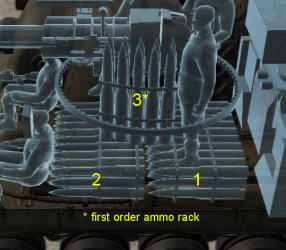
| Full ammo |
1st rack empty |
2nd rack empty |
3rd rack empty |
Visual discrepancy |
|---|---|---|---|---|
| 70 | 41 (+29) | 11 (+59) | 1 (+69) | No |
Notes:
- As they are modeled by sets of 2, shells disappear from the rack only after you fire both shells in the set.
- Rack 3 is a first stage ammo rack. It totals 10 shells and gets filled first when loading up the tank.
- This rack is also emptied early: the rack depletion order at full capacity is: 3 - 1 - 2.
- Simply not firing when the gun is loaded will move ammo from racks 1 and 2 into rack 3. Firing will interrupt the restocking of the ready racks.
Machine guns
| 12.7 mm M2HB | ||||
|---|---|---|---|---|
| Mount | Capacity (Belt) | Fire rate | Vertical | Horizontal |
| Pintle | 600 (200) | 577 | -10°/+50° | ±120° |
| 7.62 mm M1919A4 | ||||
|---|---|---|---|---|
| Mount | Capacity (Belt) | Fire rate | Vertical | Horizontal |
| Coaxial | 5,500 (250) | 500 | N/A | N/A |
Usage in battles
The tank plays almost like the M26 Pershing, it's relatively fast for its size yet has a very powerful gun. In comparison, the M46 Patton features improved manoeuvrability with increased acceleration, it also has a better gun to combat the foes it will face at its rank. Due to this, the M46 Patton can fit into multiple roles like the Pershing as an offensive or supporting unit. Attack and flank enemy units with the cooperation of allied units to get their more vulnerable sides.
At this rank, the more heavy duty vehicles appears such as the IS-3, 10.5cm Tiger II, T32, and the Maus. These tanks are a menace to not just you, but possibly your entire team. Taking these tanks out in the M46 Patton require close cooperation with other allies in order to get around and hit them in their side armour. More powerful ammunition unlocked in later modifications may improve your attempts at destroying these beasts.
Arcade Battles
The M46 plays like a light tank in Arcade, because it can reach speeds over 50 km/h in perfect conditions. Furthermore, it's very agile - turning on the spot and manoeuvring in close quarters is extremely easy. Altogether, this tank is a pleasure to play in cities in Arcade, because you can escape stand-offs and flank the enemy tank, or you may decide to bait a shot by showing your side, then instantly reversing, or you might want to just leave the encounter altogether and help out a teammate who is relatively nearby. Oh, and your agility can also help you bounce shots - just move your hull and turret around slightly if you think you will get shot.
However, the agility of the tank comes at a cost: the armour is non-existent. In the BR bracket all tanks can penetrate you anywhere. Try not to get shot at, because you're likely to be very crippled, or disabled, with a single shot.
Lastly, in Arcade, your gun is very effective. Use HEATFS rounds and the markers to try to hit as many different enemies as possible - don't try to finish them off, just go for assists. Your round is almost guaranteed to penetrate wherever you hit, and if you don't hit ammunition and take out a tank with a single shot, you are likely to take out a crew member or two, some vital component (e.g. the gun, the transmission, the engine etc.), making it very easy for your teammates to finish the enemy. You don't get a stabilizer, so caution has to be taken when peeking corners or driving around flanks.
Realistic Battles
The M46 is not as effective in Realistic, due to a much slower and focused gameplay, in the sense that a spotted vehicle is often a dead vehicle. The lack of armour doesn't help you here, either, because players take longer to aim at you, reducing any chances of lucky ricochets.
If you can't rely on armour, mobility comes into question, and in Realistic it is dampened. Here, the tank behaves much more like a general medium tank, like the Centurion or the T-34. You are mobile, and quick, but you won't be able to run away from encounters, or flank an enemy in seconds (like you can do in Arcade). Therefore, you should play much more carefully, and avoid being seen at all, which can be easily accomplished because you can still manoeuvre rather easily in close quarters.
In terms of firepower, it's still very reliable, penetration-wise. However, in Realistic it is advised to take your time to learn to identify enemy vehicles and their ammo racks, because you would want to take out enemies with a single shell (if you don't, it's harder to escape from retaliatory shots). Hence why it's advised to flank your enemies and take your time, instead of running around the map like one might do in Arcade. The HEATFS shell has a tendency to cause ammo racks detonations. Also carry some APHE shells, as more often than not, HEATFS shells have a tendency to be a bit unreliable. Even when uptiered, the M46's APHE can deal devastating blows on the enemy's armour, if you know where to aim.
In general, in Realistic, just play calm and try to create a false sense of security for the enemies. Instead of tackling someone head-on, you should retreat and let them move into your ambush, because you don't have a stabilizer, nor armour.
Pros and cons
Pros:
- Powerful 90 mm main cannon, especially with HEATFS rounds
- Great overall mobility
- Low profile
- Neutral steering
- Rear mounted transmission
- Excellent gun depression of -10 degrees
- The additional armour (fence around turret) can fend off some HEAT and HESH shells, and even ATGMs
Cons:
- Turret ring is prone to breaking
- Elevation gear is slow
- Armour can easily be pierced by other tanks at its rank
- Struggles to penetrate many opponents from the front without HEATFS
- Tendency to oversteer at high speeds in arcade battles due to high hp/ton ratio
History
M26 Pershing Modernization
At the end of World War II, the US Army's most modern tank design was the M26 Pershing heavy tank. The M26 was remarkably better than the M4A3 (76) W HVSS Sherman tank in terms of armour and gun, but was deficient in engine power as it was around ten tons heavier than the M4A3, but retained the same 500 horsepower Ford engine.[1] When tank production was halted in October 1945, the US Army had 2,212 M26s in inventory.[2] As the US Army reorganized and specified their needs for the post war period, which included the reclassification of the M26 from a heavy tank to a medium tank in May 1946,[2] the US Army sought the procurement of new tanks to make up the post-war tank fleet. However, the demilitarization and budget cuts with World War II's end heavily constrained the US Army's tank development and procurement programs. Stuck with what they had, the US Army began looking into modernizing the M26s to turn them into their desired postwar tank.[1]
The M26E2 modernization program began in January 1948.[2] As the engine was the biggest issue with the M26 Pershing, it and the transmission became the primary focus of the modernization program. Continental Motors Corporation, which was developing an engine specified by Ordnance Committee and the Tank Engine Committee since 22 July 1943, produced the AV-1790-1 engine that has significantly more horsepower than the Ford engine. Continental's AV-1790-1 engine was chosen to become part of the modernization program. The transmission was upgraded to a General Motors (GM) CD-850-1 cross drive design, a transmission design that was considered for US tank designs as far back in April 1943 during trials with the T20 tank.[3] The cross drive transmission was beneficial as it was almost twice as short as the original M26 transmission, yet is able to perform the function of a transmission, steering control, and vehicle brake.[4] Firepower improvements was also considered, with the 90 mm T54 gun as a possible upgrade option. However, this was cancelled as the 90 mm T54 introduced a new type of ammunition into the logistics train, and focus was put into improving the current 90 mm M3 in the M26. This became upgraded into the 90 mm M3A1 which saw the addition of a bore evacuator and a new single-baffle muzzle brake design.[2]
By May 1948, a complete M26E2 tank (registration number 3012420) was completed and shipped to the Aberdeen Proving Grounds.[4] Technical issues led to further improvements in the tank's components. In fiscal year 1948, the US authorized ten M26E2 tanks, with the program now designated as the medium tank T40. Changes were made to the M26 chassis for the modernization, most notably the additions of mufflers on the top of each side's fender for the engine exhaust pipes and a small track tension idler wheel between the rear sprocket and the rear road wheel. By 30 July 1948, the Ordnance Technical Committee Minutes (OTCM or OCM) 32312 designated the T40 tanks as the M46 medium tank, with the nickname "General Patton" after General George S. Patton. A production run of 800 tanks was authorized in 1949 fiscal year, with the hopes of 1,215 M26 tanks being converted to M46 standards in the 1950 fiscal year. The first M46 would roll off the production lines in November 1949, now powered by a Continental AV-1790-5A with a GM CD-850-3 transmission.[1]
Korean War Breaks Out
As the US Army began ramping up production and conversion programs for the M46 tank, the Korean War began in June 1950. The Korean War's demand for armour caused tanks in all US Army depots and stockpiles to be reactivated and sent to the Korean peninsula. This unfortunately means that the M26 Pershing tanks meant to be converted to M46s were limited. The M46, of which only 319 units were produced by the Korean War's outbreak,[2] fell into a quagmire within the US Army of not having enough M26s available to convert, but being outdated enough to not warrant the production of new units. In an effort to get new, modern tanks ready as quick as possible, it was suggested in July 1950 that the turret of an ongoing medium tank development, the T42, be placed onto the M46 hull[1] A pilot model was produced and shipped to Aberdeen Proving Ground on March 1951, designated M46E1.[5] Following further modifications, this combination would culminate into the M47 tank.
Continued field testing with the M46 and the development of the T42 led to more improvements in the M46 design. Initially designated the "M46(New)", this new improvement included a more efficient oil cooling system, new instrument panel, new hull wiring, improved brakes, and a new fire extinguishing system. A new Continental AV-1790-5B and General Motors CD-850-4 transmission was also designed that was interchangeable between the improved M46 and the T42. The "M46(New)" was eventually redesignated to M46A1 when it went into production with a contract for 360 units in 01 April 1951.[1] These M46A1 tanks started production from registration numbers 30163849 and up.[2]
M46 in Service
As the Korean War demanded large numbers of tanks, the M46 Pattons were sent alongside M4A3 Shermans and M26 Pershings into the fray. The first unit with M46 tanks in Korea was the 6th Tank Battalion, which was unloaded into Pusan on 08 August 1950.[6] The 6th Tank Battalion was soon followed by the 64th Tank Battalion on August 13th that was also equipped with M46s.[7] Of the 1,326 American tanks sent to Korea, 200 were M46 Pattons while the rest were 309 M26 Pershings, 679 M4A3 (76) W HVSS Shermans and 138 M24 Chaffees.[2]
The M46s benefitted from the more powerful powertrain to be more manoeuvrable than the M26 Pershing in the theater. However, the rapid development and fielding of the M46 showed technical problems in the field, with breakdowns associated to problems with components like the engine oil cooler fan.[8] Nevertheless, the M46s were used effectively before and after the Chinese became involved with the Korean War, with 97 M46s in the Eight Army being involved with the January 1951 counter-offensive against the Chinese.[2] One feature that was tested with the M46 Pattons was the attachment of a searchlight onto the tank to have better battlefield illumination for night battles. The original idea called for taking a M4A3 Sherman tank to be designed with a special turret accommodating a searchlight and a 75 mm gun, designated the T52 searchlight tank. An alternative solution was devised by attaching searchlights atop tank cannons, which proved to be cheap enough to not warrant a new tank design and convenient enough for any tank to be equipped with a searchlight.[6]
The Korean War would end in a ceasefire brought about by an armistice. Due to the armistice dictating the restrictions of weapon imports into the region, the M46s continued to serve there in American hands as America developed their newer tank models. By 14 February 1957, OTCM 36468 would declare the M46 and M46A1 as obsolete, with the Americans only using the M46 in Korea until they are retired from lack of spare parts.[6]
After the end of the Korean War, the M46 became part of America's weapon exports to Europe. However, as America's tank productions churn out the M47 Patton II tank, the value of the M26 and M46 for combat-ready units was not high. The M26 and M46 tanks would be exported as training vehicles to prepare crew for the receiving of M47s. Though France, Belgium, and Italy received M26s for this role, Belgium would also receive eight M46A1 that were used as training vehicles at Leopoldsburg tank training center.[2] Many more M46s would find themselves as range targets.[7]
| Archive of the in-game description | |
|---|---|
|
The M26, which appeared close to the end of World War II, was an excellent tank. However, power-to-weight ratio, manoeuvrability, and range were lacking. A special new 12-cylinder, air-cooled engine developed by Continental Motors to take care of the manoeuvrability issue reached 29,361 cm³, and at 2,800 rpm its 704 hp outstripped the M26's 500 hp. The 6.5-fold compression, which was large for the time, required 80 octane fuel, and the air-cooling system often overheated the engine. Giving the tank a new power plant required a replacement roof for the compartment housing the engine and transmission, resulting in the use of a single grating. The new automatic CD-850 gearbox and steering mechanism were operated using a single lever that served both as a gearshift and steering wheel. The M46's running gear gained another small roller to keep constant tension on the tracks and prevent them from slipping between the leading wheels and rear road wheels. In addition, the front suspension points were given second shock absorbers. The tank was built for low temperatures and had water-crossing special equipment. As a result, it was heavier, though it did not suffer from reduced speed thanks to its upgraded power plant. In 1948 the modernized tank was accepted as the M46 Patton and mass produced from 1949 through 1951. A total of 1,168 units spread across two modifications were built. The M46 medium tank was used by US forces during the Korean War from 1950 to 1953 and also served as part of the American forces in Europe. | |
Media
- Skins
- Videos
See also
External links
- [Vehicle Profile] M46 Patton
- [Global Security] M46 Patton
- [American Fighting Vehicle Data Base] Medium Tank M46 Patton
- Surviving M46 Pattons (PDF)
References
- Citations
- Bibliography
- Connor, Arthur W., Jr. 1992. "The Armor Debacle in Korea, 1950: Implications for Today". The US Army War College Quarterly, Parameters 22 (1): 66-76. Article(Archive)
- Hunnicutt, Richard P. 1971. Pershing: A History of the Medium Tank M20 Series. Berkeley, CA: Feist Publications.
- Hunnicutt, Richard P. 1984. Patton: A History of the American Main Battle Tank: Volume I. Novato, CA: Presidio Press.
- Pike, John. 2021. "M46 Patton." Global Security. Last modified January 07, 2021. Website (Archive).
- Zaloga, Steven J. 2000. M26/M46 Pershing Tank 1943-1953. Oxford: Osprey Publishing Ltd.
| USA medium tanks | |
|---|---|
| M2 | M2 |
| M3 | M3 Lee · ▃Grant I |
| M4 | M4 · Calliope · M4A1 · M4A1 (76) W · M4A2 · M4A2 (76) W · M4A3 (105) · M4A3 (76) W · M4/T26 |
| M26 Pershing | T20 · T25 · M26 · M26 T99 · M26E1 |
| M46/47/48 Patton | M46 · M46 "Tiger" · M47 · M48A1 · T54E1 · T54E2 |
| M60 | M60 · M60A1 (AOS) · M60A1 RISE (P) · M60A2 · M60A3 TTS · M728 CEV · 120S |
| MBT-70 | MBT-70 · XM803 |
| M1 Abrams | XM1 (Chrysler) · XM1 (GM) |
| M1 Abrams · M1 KVT · IPM1 | |
| M1A1 · M1A1 HC · M1A1 Click-Bait | |
| M1A2 Abrams · M1A2 SEP · M1A2 SEP V2 | |
| Other | T95E1 |
| Australia | M1A1 AIM |
| Canada | M4A5 |
| Israel | ▃Magach 3 (ERA) · ▃Merkava Mk.1 · ▃Merkava Mk.2B · ▃Merkava Mk.3D |
| Turkey | M60 AMBT |


